Karpathos History
 According to Greek mythology, the first inhabitant in Karpathos was the Titan Impetus, son of Uranus and Gaia. Archaeological findings though proved that the island was inhabited during the Neolithic times and that the Minoans had a great influence on the civilization and history of Karpathos. Some even believe that the Minoans settled on Karpathos. The Acropolis of Arkassa was built by the Mycenaeans after arriving on the island in the 14th century BC. Then came the Phoenicians and then the Dorians who settled in Karpathos around 1,000 BC and brought great prosperity, developing four fortified cities. In 478 BC, Karpathos participated in the First Athenian Alliance. It was Athens ally during the Peloponnesian Wars that took place from 431 to 404 BC, but after the Athenian defeat, the island succumbed to the Spartans. It became again part of the Athenian Alliance in 397 BC and became independent. The island of Karpathos owned Karpathos during the Hellenistic period. Then various invaders succeeded: first came the Romans, followed by the Arabs, the Sericucians, the Mauritanians, the Genovese pirate Moresco, the Venetians, and the Ottomans. But the Turks were never interested in the improvement and maintenance of Karpathos and never inhabited it. They just sent officers to collect the taxes, once in a while. With the beginning of the Greek War for Independence on 1821, Karpathos also joined the fight and offered its land for refugees and gave money for the supply of the Greek revolutionary troops and the repair of the Greek ships. The island of Karpathos became independent in 1823, becoming a province of Santorini. But, in 1830, the protocol of London gave the islands of the Dodecanese (of which Karpathos is part) to the Turks. The Italians invaded the island in 1912. They were joined by the Germans who came on Karpathos in 1943, during World War II. Finally, Karpathos became part of the independent Greek State in 1948.
According to Greek mythology, the first inhabitant in Karpathos was the Titan Impetus, son of Uranus and Gaia. Archaeological findings though proved that the island was inhabited during the Neolithic times and that the Minoans had a great influence on the civilization and history of Karpathos. Some even believe that the Minoans settled on Karpathos. The Acropolis of Arkassa was built by the Mycenaeans after arriving on the island in the 14th century BC. Then came the Phoenicians and then the Dorians who settled in Karpathos around 1,000 BC and brought great prosperity, developing four fortified cities. In 478 BC, Karpathos participated in the First Athenian Alliance. It was Athens ally during the Peloponnesian Wars that took place from 431 to 404 BC, but after the Athenian defeat, the island succumbed to the Spartans. It became again part of the Athenian Alliance in 397 BC and became independent. The island of Karpathos owned Karpathos during the Hellenistic period. Then various invaders succeeded: first came the Romans, followed by the Arabs, the Sericucians, the Mauritanians, the Genovese pirate Moresco, the Venetians, and the Ottomans. But the Turks were never interested in the improvement and maintenance of Karpathos and never inhabited it. They just sent officers to collect the taxes, once in a while. With the beginning of the Greek War for Independence on 1821, Karpathos also joined the fight and offered its land for refugees and gave money for the supply of the Greek revolutionary troops and the repair of the Greek ships. The island of Karpathos became independent in 1823, becoming a province of Santorini. But, in 1830, the protocol of London gave the islands of the Dodecanese (of which Karpathos is part) to the Turks. The Italians invaded the island in 1912. They were joined by the Germans who came on Karpathos in 1943, during World War II. Finally, Karpathos became part of the independent Greek State in 1948.
Karpathos Sightseeing
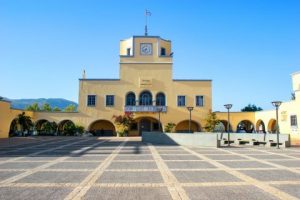 Province House
Province House
Pigadia
The Province House of Karpathos and Kasos is located close to the port of Pigadia. It is a nice three-storey building with impressive architecture. A center that provides information on the endangered species of Monachus-Monachus, the Mediterranean seal, operates in this building.
 Acropolis of Arkassa Arkassa The Acropolis of Arkassa is located on top of a hill with a gorgeous view of the sea. Remains from the ancient till the Venetian times are seen in the area as well as ruins from the ancient temple of Lindia Athena.
Acropolis of Arkassa Arkassa The Acropolis of Arkassa is located on top of a hill with a gorgeous view of the sea. Remains from the ancient till the Venetian times are seen in the area as well as ruins from the ancient temple of Lindia Athena.
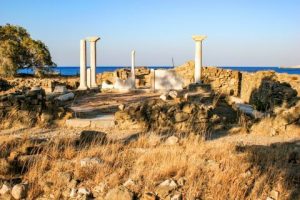 Ancient Potideon Pigadia The ruins of this ancient city, ancient temples and can be seen in the harbor of Pigadia. Tombs with ceramics dating back to the Minoan and Mycenaean periods have been brought to light, testifying the existence of an ancient settlement.
Ancient Potideon Pigadia The ruins of this ancient city, ancient temples and can be seen in the harbor of Pigadia. Tombs with ceramics dating back to the Minoan and Mycenaean periods have been brought to light, testifying the existence of an ancient settlement.
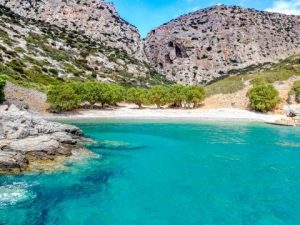 Saria Islet Saria This mountainous islet was once attached to the island, but now a short strip of sea separates them. There are monuments from the antiquity and the Byzantine times on it. Saria can be reached by tour boat from Pigadia.
Saria Islet Saria This mountainous islet was once attached to the island, but now a short strip of sea separates them. There are monuments from the antiquity and the Byzantine times on it. Saria can be reached by tour boat from Pigadia.
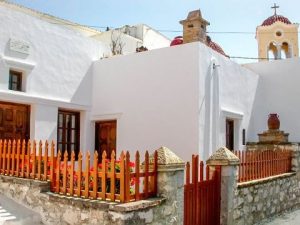 Othos Folklore Museum Othos The Folk Museum of Othos Karpathos is housed in the traditional house of Varikas and Aristotle Stavrakis, which is a typical example of a fine Karpathian house. The museum was created by the Association of “Work and Fun” of Othos and exhibits a rich collection of authentic folk pieces of Karpathos.
Othos Folklore Museum Othos The Folk Museum of Othos Karpathos is housed in the traditional house of Varikas and Aristotle Stavrakis, which is a typical example of a fine Karpathian house. The museum was created by the Association of “Work and Fun” of Othos and exhibits a rich collection of authentic folk pieces of Karpathos.
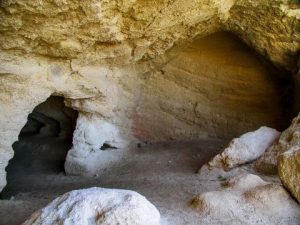 Cave of Poseidon Pigadia This cave is a great natural site of the island. In the ancient times, it was used as a sanctuary either to god Poseidon or to goddess Aphrodite.
Cave of Poseidon Pigadia This cave is a great natural site of the island. In the ancient times, it was used as a sanctuary either to god Poseidon or to goddess Aphrodite.
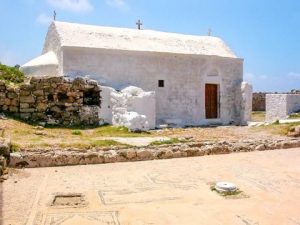 Agia Sofia Arkassa The small church of Agia Sofia is located close to Arkassa. This is one of the oldest churches on the island.
Agia Sofia Arkassa The small church of Agia Sofia is located close to Arkassa. This is one of the oldest churches on the island.
 Sokastro Islet Lefkos Sokastro used to be attached to the rest of the island but now it is a separate islet. It has monuments from the Medieval and the Byzantine times.
Sokastro Islet Lefkos Sokastro used to be attached to the rest of the island but now it is a separate islet. It has monuments from the Medieval and the Byzantine times.
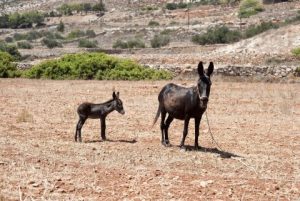 Kasos Island Kasos Kasos is a small but beautiful island very close to Karpathos. It is ideal for peaceful vacations. Its welcoming inhabitants and the natural beauties of the island will amaze visitors. Ferries connect Kasos to Karpathos and Ierapetra Crete.
Kasos Island Kasos Kasos is a small but beautiful island very close to Karpathos. It is ideal for peaceful vacations. Its welcoming inhabitants and the natural beauties of the island will amaze visitors. Ferries connect Kasos to Karpathos and Ierapetra Crete.
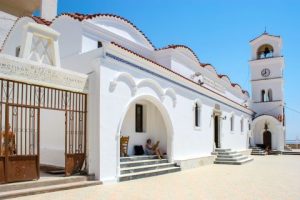 Church of the Assumption Menetes The church of the Assumption of the Virgin Mary in Menetes was constructed in the 19th century. This is the most famous church of the island and gives an amazing view of the surrounding region. For its construction, columns from the ancient site of Arkassa were used.
Church of the Assumption Menetes The church of the Assumption of the Virgin Mary in Menetes was constructed in the 19th century. This is the most famous church of the island and gives an amazing view of the surrounding region. For its construction, columns from the ancient site of Arkassa were used.
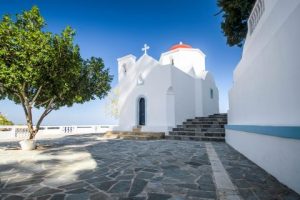 Church of Virgin Mary Kyra Panagia This small church above Kyra Panagia beach is dedicated to the Virgin Mary. It is locally known as the church of Kyra Panagia. Constructed in traditional style and colors, its location offers an amazing view of the sea.
Church of Virgin Mary Kyra Panagia This small church above Kyra Panagia beach is dedicated to the Virgin Mary. It is locally known as the church of Kyra Panagia. Constructed in traditional style and colors, its location offers an amazing view of the sea.
Karpathos Things to do
 Things to do in Karpathos are limited, as the island is not much developed in tourism. The most organized activity is windsurfing in the bay of Afiartis, on the southwestern side of the island. This is the most popular bay for windsurfing on Karpathos island and even an international windsurfing competition is organized every summer. Diving is also a developing activity in Karpathos, especially after the legislation change in 2006 that now allows diving in the marine park between the islands of Karpathos and Kassos. As for other activities on the island, swimming and hiking are the only options. The countryside of Karpathos is signposted and hiking trails lead to old chapels, mountainous villages, secluded beaches, and hilltops with a great view of the sea.
Things to do in Karpathos are limited, as the island is not much developed in tourism. The most organized activity is windsurfing in the bay of Afiartis, on the southwestern side of the island. This is the most popular bay for windsurfing on Karpathos island and even an international windsurfing competition is organized every summer. Diving is also a developing activity in Karpathos, especially after the legislation change in 2006 that now allows diving in the marine park between the islands of Karpathos and Kassos. As for other activities on the island, swimming and hiking are the only options. The countryside of Karpathos is signposted and hiking trails lead to old chapels, mountainous villages, secluded beaches, and hilltops with a great view of the sea.

